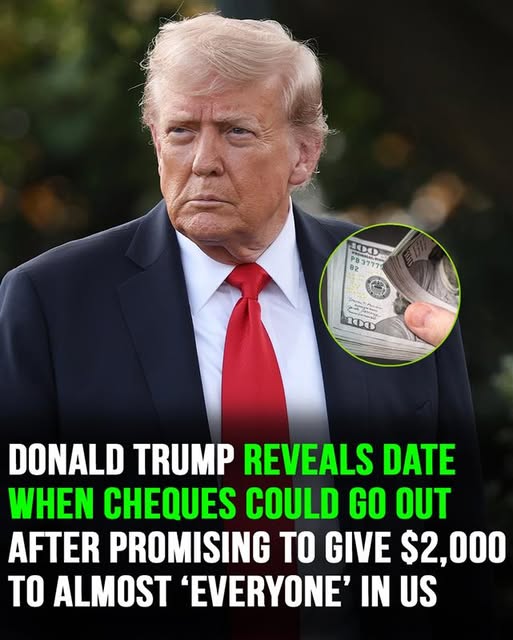When Donald Trump speaks, the world listens—not simply because he is a political figure, but because he has spent years cultivating a reputation for bold declarations, dramatic promises, and provocative policy ideas that often dominate national conversations.Throughout his political career, Trump has made countless pledges ranging from sweeping immigration reform to transformative economic initiatives, some of which materialized, others which dissolved before reaching implementation. Yet his latest promise—a pledge to give nearly every American a $2,000 “dividend” payment—is unlike anything he has said before. It is not about policy theory, not about governmental philosophy, and not about ideological shifts.
It is a promise that affects individual households directly, one that has captured the attention of millions who are grappling with rising costs, financial pressures, and a desire for economic relief. For many, the idea of receiving a $2,000 check has an instant emotional impact. It feels tangible. Immediate. Personal. But as with many political proposals that appear simple on the surface, the reality is far more complex.
To fully understand the significance, the controversy, and the feasibility of Trump’s promise, we need to look closer—at the economic foundation behind it, the political motivations, the legal constraints, and the historical implications. Only then does the picture become clear.
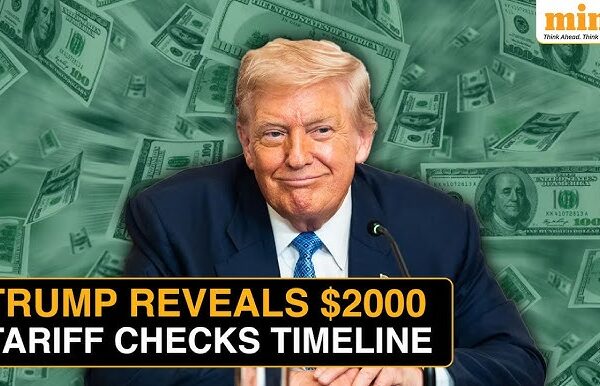
A Promise That Sparked Instant Headlines
The story began when Trump took to Truth Social with one of his trademark posts—part political messaging, part economic defense, part rallying cry. In it, he insisted that his tariff system was generating massive government revenue, fueling economic strength, and empowering the nation in ways critics refuse to acknowledge.He wrote: “People that are against Tariffs are FOOLS! With Almost No Inflation, and A Record Stock Market Price. 401k’s are Highest EVER. We are taking in Trillions of Dollars and will soon begin paying down our ENORMOUS DEBT.” Then came the line that stunned even many of his supporters:
“A dividend of at least $2000 a person (not including high income people!) will be paid to everyone.” With those few words, Trump transformed a complicated economic discussion into a deeply personal one. Suddenly, the focus was not on macroeconomics, but on households. Not on national revenue, but on individual relief. Political analysts immediately noted that the pledge could become one of the most memorable promises in modern American history—if it happens.
Why the Word “Dividend” Matters
Trump’s use of the word “dividend” is not accidental. A dividend, in the financial world, is a payment issued to shareholders based on the profits of a company. By using that term, Trump is framing the American people not simply as taxpayers, but as stakeholders—as individuals who are entitled to a share of revenue generated by national economic policy.Symbolically, it positions Trump as someone sharing the nation’s success with ordinary Americans. Strategically, it sets the stage for a political narrative centered on direct benefit—something citizens will remember long after speeches and debates fade. But practically, it raises major questions:
- Is tariff revenue stable enough to fund such payments?
- Can the government legally distribute money this way?
- Would Congress approve a massive payout?
- Who exactly qualifies as “high income” and therefore excluded?
Those questions lead us to the core of the controversy.
The Economics Behind the Promise
Tariffs are effectively taxes placed on imported goods. Trump has long insisted that tariffs force foreign countries—particularly China—to pay the U.S. government billions. Critics argue that tariffs function as indirect taxes on American businesses and consumers, raising prices and shifting costs domestically. Supporters believe tariffs create leverage, strengthen American manufacturing, and generate substantial revenue.
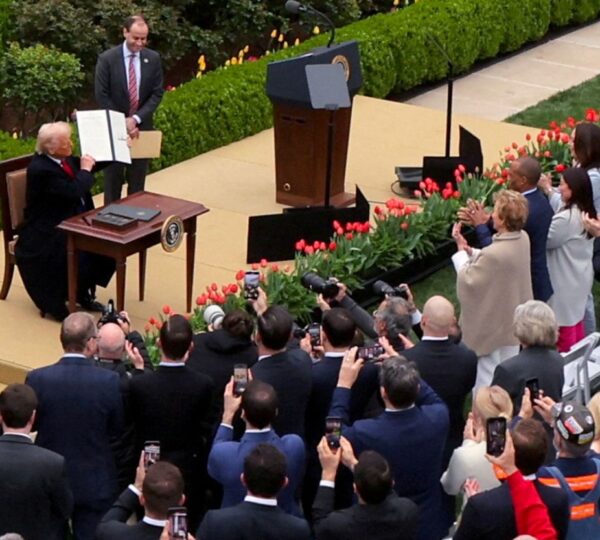
In Trump’s view, that revenue is large enough to justify widespread payments to Americans. Economists, however, quickly pointed out a significant problem: The math doesn’t add up. Nonpartisan analysts estimate:
- If every qualifying American received $2,000
- And if the income cutoff is around $100,000
- Approximately 150 million adults would be eligible
- Total cost: around $300 billion minimum
That is nearly three times the total net revenue generated by tariffs so far. Economist Erica York broke it down clearly: “Tariffs have raised approximately $90 billion in net revenues. That is nowhere near enough to fund a $300 billion rebate.” Her conclusion is blunt: Tariff money alone cannot sustain Trump’s dividend plan—unless revenue dramatically increases or additional funding sources are introduced.
The Legal Challenges Threatening the Entire Plan
If economic obstacles weren’t enough, the legal challenges are equally serious. At the heart of the issue is whether Trump used presidential emergency powers appropriately to impose certain tariffs. Multiple lower courts have ruled the approach illegal, arguing that the administration exceeded its authority. The Supreme Court has heard arguments, and its decision carries enormous consequences:
✔ If the Court upholds the tariffs → Revenue continues
✘ If the Court strikes them down → Revenue disappears and the dividend becomes impossible
In other words: The $2,000 payments depend entirely on the survival of Trump’s tariff system.
Trump’s Timeline: Pushing the Promise to 2026
After widespread questions about feasibility, Trump provided a critical update. Speaking to reporters aboard Air Force One, he stated that the dividend payout would take place next year—meaning 2026. He explained: “It will be next year… The tariffs allow us to give a dividend. We’re going to do a dividend and we’re also going to be reducing debt.”But Treasury Secretary Scott Bessent added a dose of realism: “We will see. We need legislation for that.” That statement is crucial. It means the following: Congress must approve the payouts. This is not something Trump can authorize on his own. A divided Congress could block the plan entirely.
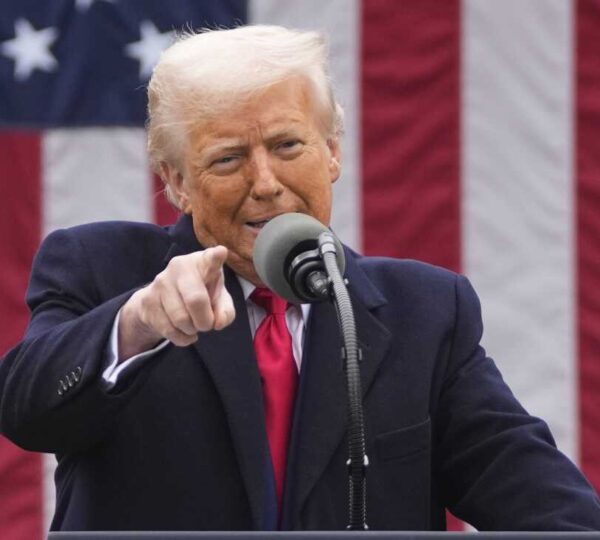
Why This Promise Is Politically Risky — but Powerful
Politicians make promises constantly. Most are vague. Most are difficult to measure. Most can be interpreted a dozen different ways. But this promise is different. When Trump says:➡️ “I will give you $2,000.”
There is no room for interpretation.
The outcome is binary:
- Either Americans receive the payment,
- Or they don’t.
That level of clarity makes the promise both powerful and dangerous. If it succeeds, it will be remembered as a landmark achievement. If it fails, it could damage trust among voters who take the pledge literally.
Why Americans Are Paying Attention
Economic pressure remains a major concern for millions of people. Across the country, households are dealing with:
- Rising grocery prices
- Expensive rent and mortgages
- High interest rates
- Student loan burdens
- Increasing medical costs
- Wage stagnation
A $2,000 payment would create immediate relief for families living paycheck to paycheck, retirees living on fixed incomes, young adults starting their lives, and parents struggling to provide. Even people skeptical of Trump politically admit that the idea of a government dividend is appealing. In a time of economic anxiety, this kind of promise lands differently.
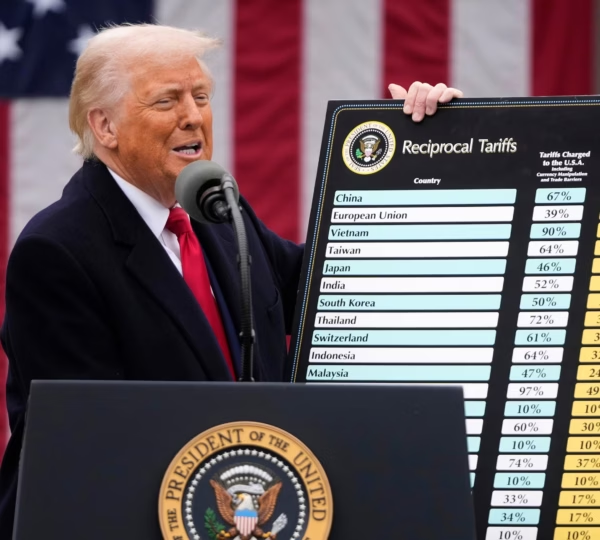
Where Things Stand Now
As of now, the situation is this:
✔ Trump has promised $2,000 payments
✔ They would be funded through tariff revenue
✔ Economic analysts say there isn’t enough revenue
✔ Legal challenges could eliminate tariff income entirely
✔ Congress must approve the plan
✔ Trump says the earliest possible date is 2026
The promise exists in a complicated intersection of economics, law, politics, and public expectation. It is bold, dramatic, and attention-grabbing — but also uncertain, expensive, and dependent on forces beyond Trump’s control. As the initial shockwave of Trump’s $2,000 dividend promise settled, the political world began dissecting what the proposal truly means — not just for fiscal policy or the economy, but for the future of American elections.The idea of a nationwide payout is now echoing through congressional halls, cable news networks, political forums, and living rooms across the country. Trump’s message is simple. The implications are anything but. While Part 1 explored the structure, economics, legality, and foundation of the promise, Part 2 dives into the broader consequences:the political reactions, expert analysis, voter psychology, historical comparisons, and the potential fallout if the promise succeeds — or collapses. Because a promise of this magnitude doesn’t just live in the economic sphere. It reshapes the political battlefield itself.
The Immediate Political Reaction: Shock, Panic, and Strategic Silence
When Trump posted his dividend announcement, political strategists across the spectrum reacted in dramatically different ways. Democrats were caught off guard. Many Democratic lawmakers were hesitant to respond, knowing that opposing the payout risks appearing out of touch with working-class families. Others criticized it as financially irresponsible, calling it a “gimmick,” “impossible math,” or “vote-buying with imaginary money.”However, few dared to directly tell Americans: “You will not get this money.” Even critics understand the danger of being seen as standing between voters and cash. Republicans were split. Moderate Republicans appeared wary of the enormous cost and legal challenges. Populist Republicans embraced the idea immediately, framing it as a “return of wealth to the American people.”High-profile figures on the right began repeating phrases like:
- “Tariff dividend”
- “America’s shareholder payout”
- “Returning stolen prosperity”
A narrative began to form — one centered not on government spending, but on reclaiming economic power from foreign nations. Economists were blunt. Many financial experts doubted the feasibility of generating enough tariff revenue, raising concerns about supply chain impacts, price increases, and legal challenges. But analysts also conceded an uncomfortable reality: The promise is politically powerful — and extremely difficult to counter.
How Voters Are Responding: Hope, Skepticism, and a New Expectation
Public reaction has been both emotional and complex. For millions, the promise feels like hope. In a time of high prices, stagnant wages, and financial stress, $2,000 represents:
- Rent
- A medical bill
- A credit card payment
- A month of childcare
- Much-needed breathing room
Even voters who don’t fully trust political promises admit the idea is alluring.
Others remain skeptical.
Some Americans believe the pledge is unrealistic or designed purely for political gain. However, skepticism doesn’t erase interest — if anything, it heightens it. Why? Because people want clarity. They want to know what is real, what is possible, and what they should expect. A new standard may have been set.Whether the promise is fulfilled or not, Trump has introduced a new concept into the national conversation: Direct economic dividends paid from national policy revenues. Even rival politicians may feel pressure to respond with their own versions of the idea. Once the public imagines a $2,000 payout, everything else feels smaller.
Historical Context: How Big Promises Shape Elections
Throughout American history, transformative promises have helped shift political landscapes:
- Franklin Roosevelt promised sweeping economic relief during the Great Depression.
- Lyndon Johnson promised “The Great Society.”
- Ronald Reagan promised tax cuts that would “reignite American prosperity.”
- Barack Obama promised universal healthcare reforms.
- Trump himself previously promised a border wall funded by Mexico, which became a defining symbol of his first campaign.
But the $2,000 dividend promise is different.
It offers something:
- Immediate
- Personal
- Direct
- Quantifiable
- Hard to forget
It is rare for a politician to offer such a concrete, measurable pledge. That alone makes the promise historically significant.
The Boomerang Effect: What Happens if the Promise Fails?
While the dividend plan has magnetic appeal, it carries one of the biggest political risks a president can take. If Americans do not receive the $2,000 Trump promised, the fallout could be immense.
1. Voter disappointment → frustration → backlash
People rarely forget when money is promised and not delivered.
2. Political opponents will weaponize the failure
A broken financial promise gives rivals ammunition that lasts for years.
3. Economic pressure intensifies the emotional reaction
For households in hardship, the disappointment cuts deeper.
4. The expectation becomes a new political standard
Future candidates may be judged against Trump’s promise, pressured to produce their own version. This is why many analysts describe it as one of the boldest — and riskiest — political pledges of the modern era.
The Boomerang Effect in Reverse: What Happens If Trump Succeeds?
Though the obstacles are significant, it’s worth considering the alternative scenario:
If Trump delivers the $2,000 dividend, even once, he will achieve something unprecedented in modern policy history.
Such a payout would:
- Transform his political legacy
- Cement his influence on economic policy
- Shift public expectations permanently
- Create a template future administrations may follow
- Strengthen his standing among economically stressed voters
- Trigger global debate about tariff-funded dividends
It would be one of the most consequential financial interventions by a U.S. president in decades.
The Legislative Battlefield: Why Congress Holds the Final Key
Treasury Secretary Scott Bessent made it clear:
“We need legislation for that.”
This means:
✔ Congress must approve the funding
✔ Congress must define eligibility
✔ Congress must authorize distribution
Even a supportive administration cannot move forward without congressional cooperation.
This introduces enormous unpredictability:
- Will Democrats oppose it out of principle?
- Will Republicans divide over cost concerns?
- Will moderates push for alternatives?
- Will expansions or restrictions be added?
The legislative path is as uncertain as the economic one.
The Legal Variable: The Supreme Court’s Upcoming Decision
The Supreme Court’s ruling on tariff authority will determine whether the financial foundation of the plan even exists. If Trump won the legal argument: Tariffs remain intact → revenue continues → dividend is theoretically possible.
If Trump lost the legal argument: Tariffs collapse → revenue disappears → dividend becomes impossible. This single decision could either ignite the plan or extinguish it entirely.
Why the Promise Still Matters — Even If It Never Happens
Political promises are not just about policy. They shape narratives, beliefs, expectations, and voting behavior. Trump’s dividend pledge signals:
1. Economic frustration is widespread
Voters want direct relief.
2. Traditional political messaging is losing power
People respond more to personal financial benefit than to ideological speeches.
3. Americans expect more from national revenue
They want to feel its benefits in their wallets.
4. Presidential candidates may begin competing with financial incentives
This could mark the beginning of a new era in American elections.
5. The idea of “tariff-funded dividends” is becoming mainstream
Regardless of feasibility, the concept is now part of the national conversation.
The Final Question: Will Trump Deliver?
The truth, as it stands today:
✔ The idea is appealing
✔ The economics are challenging
✔ The legality is uncertain
✔ The politics are complicated
✔ The timeline is ambitious
✔ The promise is unforgettable
Trump’s pledge may ultimately become:
- A milestone achievement, or
- A high-risk gamble remembered for generations
But one thing is absolutely certain: This is a promise Americans will not forget — whether it succeeds or fails.
